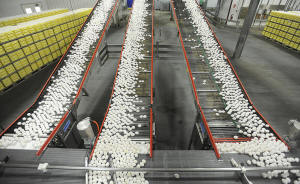Egg prices could jump 41% this year, USDA says, as Trump's bird flu plan
is unveiled
 [February 27, 2025] By
JOSH FUNK and JOSH BOAK [February 27, 2025] By
JOSH FUNK and JOSH BOAK
WASHINGTON (AP) — The U.S. Agriculture Department predicts record egg
prices could soar more than 40% in 2025, as the Trump administration
offered the first new details Wednesday about its plan to battle bird
flu and ease costs.
With an emphasis on farms tightening their measures to prevent bird
flu's spread, Agriculture Secretary Brooke Rollins said the USDA will
invest another $1 billion on top of the roughly $2 billion it has
already spent since the outbreak began in 2022.
The main reason egg prices have climbed — hitting an all-time average
high of $4.95 per dozen this month — is that more than 166 million birds
have been slaughtered to limit the virus' spread when cases are found.
Most were egg-laying chickens. Just since the start of the year, more
than 30 million egg layers have been killed.
What more can farmers do to stop bird flu?
Egg and poultry farmers have already been working since the bird flu
outbreak of 2015 to protect their birds by making workers change clothes
and shower before entering barns, using separate sets of tools, and
sanitizing any vehicles that enter farms. The challenge is that wild
birds easily spread the virus.
The USDA is working on identifying the most effective measures farmers
can take and helping spot any weaknesses in their plans.
The department has already done biosecurity reviews on about 150 farms
and only one had an outbreak afterward, the USDA said, so officials
believe more can be done to protect birds and they are going to make
those reviews available to more farms. Any farm that has an outbreak now
has to undergo a biosecurity audit. And the government will help pay up
to 75% of the needed biosecurity improvements.

Egg prices will get much worse this year
The USDA now predicts the cost of eggs will go up 41.1% this year. Just
last month, the increase was predicted to be 20%.
And the average prices conceal just how bad the situation is, with
consumers paying more than a dollar per egg — over $12 a dozen — in some
places.
Prices have more than doubled since before the outbreak began, costing
consumers at least $1.4 billion last year, according to an estimate by
agricultural economists at the University of Arkansas. Restaurants like
Denny’s and Waffle House started adding surcharges to egg dishes.
Egg prices also normally increase every spring heading into Easter when
demand is high.
Will the Trump plan bring down prices?
Rollins acknowledged that it will take some time before consumers see an
effect at the checkout counter. It takes infected farms months to
dispose of the carcasses, sanitize their farms and raise new birds. But
she expressed optimism that the plan will help prices.
“It’s going to take a while to get through, I think in the next month or
two, but hopefully by summer,” Rollins said.
[to top of second column] |

In this July 28, 2012 file photo, chicken eggs are transported by
conveyor belt from the production side to the packaging side at a
farm in Cortland, Ind. (Aaron Piper/The Tribune via AP, File)
 CoBank analyst Brian Earnest said he
appreciates the Trump administration's fresh look at the problem,
but “I don’t see a whole lot here that is a big change here from the
current plan of action.”
Major trade groups in the egg, chicken, turkey and dairy industries
largely praised the plan. American Egg Board President Emily Metz
said she is encouraged the administration wants to find the best
response through a combination of biosecurity and exploring vaccine
development.
Will DOGE layoffs affect the bird flu fight?
Rollins said she believes the USDA has enough staff to respond to
bird flu even after all the cuts to the federal workforce at the
direction of Elon Musk’s Department of Government Efficiency.
“Will we have the resources needed to address the plan I just laid
out? We are convinced that we will,” she said, “as we realign and
evaluate where USDA has been spending money, where our employees are
spending their time.”
Democratic U.S. Sen. Amy Klobuchar said the new plan is an important
step, but USDA needs to confirm it rehired everyone involved in the
bird flu response who was mistakenly fired.
Where's the money going?
The plan calls for $500 million investment to help farmers bolster
biosecurity measures, $400 million in additional aid for farmers
whose flocks have been impacted by avian flu, $100 million to
research and potentially develop vaccines and therapeutics for U.S.
chicken flocks and explore rolling back what the administration sees
as restrictive animal welfare rules in some states like California's
cage-free requirement approved by voters.
The USDA has already paid farmers roughly $1.2 billion for the birds
they had to slaughter. The additional aid will continue going to
those payments and help farmers bring in new flocks more quickly.
The administration is in talks to import about 70-100 million eggs
from abroad in the coming months, Rollins said. But there were 7.57
billion table eggs produced last month, so those imports don't
appear likely to make a significant difference in the market.
Trump administration officials have suggested that vaccines might
help reduce the number of birds that have to be slaughtered when
there is an outbreak. However, no vaccines have been fully approved
for widespread use in poultry, and the industry has said the current
prototypes aren't practical because they require individual shots
for each bird. Plus, vaccinated birds could jeopardize exports.
___
Funk reported from Omaha, Nebraska. Aamer Madhani in Washington
contributed.
All contents © copyright 2025 Associated Press. All rights reserved |